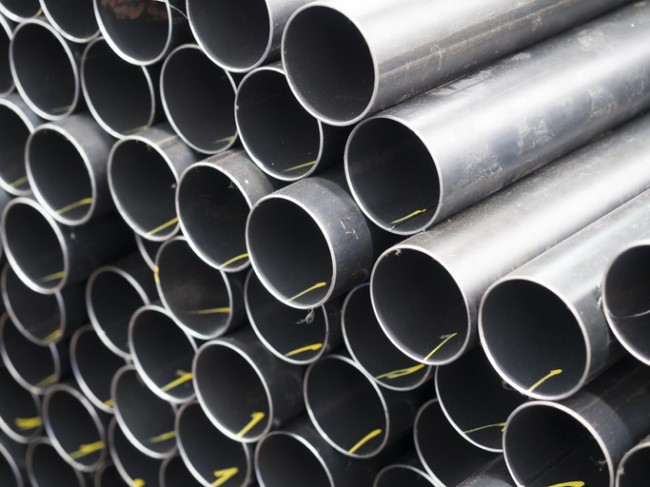Hot Dipped Galvanized Steel Pipe At Bushwick Metals/Intsel Steel East

If you work in an industry that installs or utilizes piping, you know how important reliability is. It means improved safety as well as increased production. It can be the difference between successful transport of liquids or gases and disaster.
With so many different components on the market, it can be difficult to determine which is the best piping for any given project. Fortunately, there are a few products that stand out above the rest. Hot dip galvanized pipe is one of them.
There are many advantages to zinc-galvanized piping. The information below will go over them as well as the preparation and coating processes. It will help you determine if galvanized pipe is the right product for your business needs.
What Is Galvanization?
While steel is a very durable metal with a high tensile strength, without protection, it will rust. Galvanization is the process of adding a protective layer of material–usually zinc–to steel or iron. This strengthens the metal and protects it from rust and corrosion.
The most common method for galvanizing metal is hot dipping. As the name suggests, it involves dropping the metal into a molten zinc solution to coat it.
First, the steel surface is cleaned to ensure it is free of any contamination. It is often degreased by dipping it in hydrochloric acid. This also helps remove rust, welding slag, paint, or any other unwanted materials. Next, technicians dip the steel in zinc that is heated to well over 800 degrees Fahrenheit. Zinc alloy layers form on the steel and then cool to form a solid coat. Finally, metal workers inspect the finished product. They look for uniformity of coating and inspect the thickness of the layers. Sometimes they perform basic physical or chemical tests to determine the quality of the coating.
Advantages of Hot Dip Galvanized Steel Pipe
There are several benefits to zinc galvanization. Here are the main ones to consider.
Durability
Galvanized steel will last many decades–depending on the conditions in which it is used–much longer than many other piping products. For heavy industrial uses, you can expect it to last 15 or 20 years. You could get more like 30, 40, or even 100 years from the piping for residential uses. Zinc is very strong and has a very low rate of corrosion. It helps Galvanization protect the underlying steel in three distinct ways.
Physical Barrier
The most obvious way zinc protects the metal piping is by creating a robust physical barrier. Zinc is a strong metal itself and is resistant to cracking or chipping. Other sealants are not as strong. When damaged, they can expose the steel to water or moisture in the air, which can cause corrosion. Hot dip galvanized pipe is completely coated to create a singular layer and can provide up to seven times the strength of organic coatings.
Corrosion
Another way galvanization provides protection is from corrosion. The most prominent and rapid way corrosion happens in metals is when two come into contact with one another in the presence of an electrolyte, like saltwater.
One metal acts as an anode and the other as a cathode. The anode corrodes more rapidly, while the cathode corrodes slower than it otherwise would. When galvanized, the zinc coating, in contact with the base steel, acts as the anode. This slows the corrosion rate of the cathode metal (the steel). It is easy to see how this is preferable to organic or plastic coatings. This “sacrificial protection” means that, given the presence of an electrolyte, the zinc will corrode much faster than the underlying steel. Also, it is much easier to repair and replace the damaged zinc coating than the entire pipe itself should outer corrosion occur.
Sideways Creep
Finally, zinc protects against a type of corrosion known as “sideways creep.” This involves rust deposits accumulating and spreading underneath the paint coating. This causes it to peel and flake. Zinc is resistant to this dynamic. So, any corrosion remains localized and is easier to address.
Cost
Longer-lasting piping translates to economic benefits down the road. You save not only on the product itself but offsetting labor costs associated with replacing corroding pipe. It also means you don’t have to shut down operations to do repairs or replacements. Galvanized steel pipe is also much more affordable to produce than other long-lasting metals, like stainless steel. This is in part because these alternatives require a lot of labor and many steps to produce.
Efficient Preparation and Inspection
Galvanization also requires very little preparation of the steel pipe’s surface. While the metal should be free of dust or debris, no other steps are necessary (other than minor decreasing ones mentioned above) to ensure the zinc coating adheres to the surface.
The galvanization process–including preparation, dipping, and drying–is very quick. Also, it is not harmed by humidity, so that you can do it in almost any climate or weather condition. Galvanized steel pipe is much easier to inspect than other coated pipes. The shiny sheen the process leaves behind makes it simple to identify imperfections or deficits in the evenness of the coating.
Find Hot Dip Galvanized Pipe Near You
Now that you have an idea of the advantages of hot dip galvanized steel, you can determine if it’s right for your construction needs. Be sure to find a reputable distributor that has a lot of experience in the galvanization process to ensure you’re getting a quality product.
For almost 200 years, Bushwick Metals has been the Northeast’s leading wholesale steel distributor. We carry a vast inventory of premium carbon steel products, including hot dip galvanized pipe. Reach out to us today for a free quote or to speak with someone from our sales team about your piping needs.






